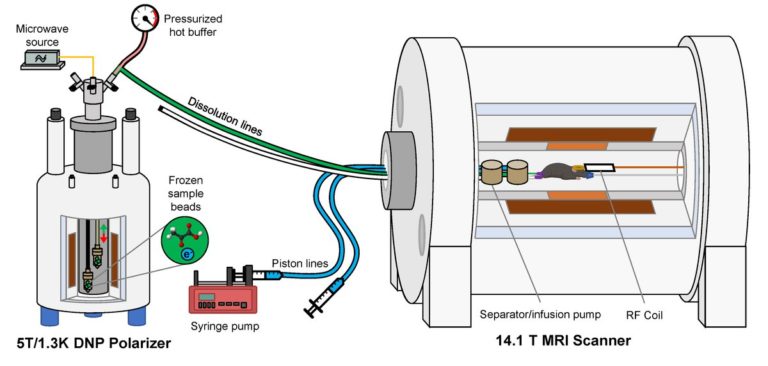371. Highly versatile dissolution DNP: implementation of a multi- sample/multi-nucleus cryogenic probe with parallel NMR detection
Thanh Phong Lê, Jean-Noël Hyacinthe and Andrea Capozzi; Scientific Reports (2023); DOI: 10.21203/rs.3.rs-2560514/v1 (open access)
Dissolution Dynamic Nuclear Polarization (dDNP) is the most versatile hyperpolarization technique to enhance NMR sensitivity in the liquid state. The unprecedented signal enhancement is the key for a large range of applications spanning from fast chemical reaction monitoring to metabolism investigation in real time. Unfortunately, this exceptional time resolution does not come without a price. Low throughput is one of dDNP main shortcomings. Especially for clinical and preclinical applications, where direct 13C nuclei polarization is usually pursued, it takes hours to generate one single hyperpolarized (HP) sample. Therefore, being able to hyperpolarize more samples at once represents a clear advantage and can expand the range and complexity of the applications. Some clinical and preclinical systems are equipped with a multi-sample option. Nevertheless, the solid-state NMR detection is far from optimal, not being sample selective or requiring the displacement of the sample to acquire and monitor its signal.
In this work, we present the design and performance of a highly versatile and customizable dDNP cryogenic probe, herein adapted to a 5 T “wet” preclinical polarizer, that can not only accommodate up to three Custom Fluid Paths (CFPs), but it is also capable of monitoring the solid-state dynamics of each sample separately, thanks to dedicated pseudo-Alderman-Grant coils and multi-nuclei parallel Nuclear Magnetic Resonance (NMR) acquisition on three distinct channels. Within 30 min, the system was able to dispense three HP solutions with high repeatability across the channels (30.0 ± 1.2% carbon polarization for [1-13C]pyruvic acid doped with trityl radical). Moreover, we tested multi-nucleus NMR capability by polarizing and monitoring simultaneously 13C, 1H and 129Xe. Finally, we implemented [1-13C]lactate/[1-13C]pyruvate polarization and back-to-back dissolution and injection in a healthy mouse model to perform multiple-substrate HP Magnetic Resonance Spectroscopy (MRS) at 14.1 T.
